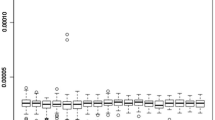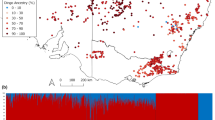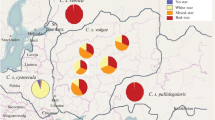Abstract
Melanism is not considered a typical characteristic in wolves of Iran and dark wolves are believed to have originated from crossbreeding with dogs. Such hybrid individuals can be identified with the combined use of genetic and morphological markers. We analyzed two black wolves using a 544 base pairs (bp) fragment of the mtDNA control region and 15 microsatellite loci in comparison with 28 dogs, 28 wolves, and four known hybrids. The artificial neural networks (ANNs) method was applied to microsatellite data to separate genetically differentiated samples of wolves, dogs, and hybrids, and to determine the correct class for the black specimens. Individual assignments based on ANNs showed that black samples were genetically closer to wolves. Also, in the neighbor-joining network of mtDNA haplotypes, wolves and dogs were separated, with the dark specimens located in the wolf branch as two separate haplotypes. Furthermore, we compared 20 craniometrical characters of the two black individuals with 14 other wolves. The results showed that craniometrical measures of the two black wolves fall within the range of wolf skulls. We found no trace of recent hybridization with free-ranging dogs in the two black wolves. Dark coat color might be the result of a natural combination of alleles in the coat-color-determining gene, mutation in the K locus due to past hybridization with free-ranging dogs, or the effect of ecological factors and adaption to habitat conditions.



Similar content being viewed by others
References
Aghbolaghi MA, Rezaei HR, Scandura M, Kaboli M (2014) Low gene flow between Iranian Grey Wolves (Canis lupus) and dogs documented using uniparental genetic markers. Zool Middle East 60:95–106
Anderson TM, vonHoldt BM, Candille SI, Musiani M, Greco C, Stahler DR, Smith DW, Padhukasahasram B, Randi E, Leonard JA, Bustamante CD, Ostrander EA, Tang H, Wayne RK, Barsh GS (2009) Molecular and evolutionary history of melanism in North American gray wolves. Science 323:1339–1343
Andersone Ž, Lucchini V, Ozoliņš J (2002) Hybridisation between wolves and dogs in Latvia as documented using mitochondrial and microsatellite DNA markers. Mamm Biol Z Säugetierkd 67:79–90
Apollonio M, Mattioli L, Scandura M (2004) Occurrence of black wolves in the Northern Apennines, Italy. Acta Theriol 49:281–285
Ardalan A, Kluetsch CFC, Zhang A-B, Erdogan M, Uhlén M, Houshmand M, Tepeli C, Ashtiani SRM, Savolainen P (2011) Comprehensive study of mtDNA among Southwest Asian dogs contradicts independent domestication of wolf, but implies dog–wolf hybridization. Ecol Evol 1:373–385
Aurelle D, Lek S, Giraudel J-L, Berrebi P (1999) Microsatellites and artificial neural networks: tools for the discrimination between natural and hatchery brown trout (Salmo trutta, L.) in Atlantic populations. Ecol Model 120:313–324
Azadeh A, Ghaderi SF, Sohrabkhani S (2008) A simulated-based neural network algorithm for forecasting electrical energy consumption in Iran. Energ Policy 36:2637–2644
Bennett K (2010) Genetic conservation of the Grey Wolf. http://kendellbennett.writersresidence.com/system/attachments/files/4895/original/wolf_conservation_paper.pdf
Boitani L (1992) Wolf research and conservation in Italy. Biol Conserv 61:125–132
Brewster W, Fritts S (1995) Taxonomy and genetics of the gray wolf in western North America: a review. In: Carbyn LN, Fritts SH, Seip DR (eds) Ecology and conservation of wolves in a changing world. Canadian Circumpolar Institute, University of Alberta, Edmonton, pp 353–374
Carmichael LE, Krizan J, Nagy JA, Fuglei E, Dumond M, Johnson D, Veitch A, Berteaux D, Strobeck C (2007) Historical and ecological determinants of genetic structure in arctic canids. Mol Ecol 16:3466–3483
Ciucci P, Lucchini V, Boitani L, Randi E (2003) Dewclaws in wolves as evidence of admixed ancestry with dogs. Can J Zool 81:2077–2081
Cornuet J-M, Aulagnier S, Lek S, Franck S, Solignac M (1996) Classifying individuals among infra-specific taxa using microsatellite data and neural networks. C R Acad Sci III 319:1167–1177
del Zorro Rojo EM (2005) Morphometric examination of red fox (Vulpes vulpes) from the Van-Yoncatepe necropolis in eastern Anatolia. Int J Morphol 23:253–260
Douzery E, Randi E (1997) The mitochondrial control region of Cervidae: evolutionary patterns and phylogenetic content. Mol Biol Evol 14:1154–1166
Ermis K, Midilli A, Dincer I, Rosen MA (2007) Artificial neural network analysis of world green energy use. Energ Policy 35:1731–1743
Excoffier L, Laval G, Schneider S (2005) Arlequin (version 3.0): an integrated software package for population genetics data analysis. Evol Bioinformatics Online 1:47
Freeland JR (2005) Molecular ecology. John Wiley & Sons, Chichester
Geffen ELI, Anderson MJ, Wayne RK (2004) Climate and habitat barriers to dispersal in the highly mobile grey wolf. Mol Ecol 13:2481–2490
Guo SW, Thompson EA (1992) Performing the exact test of Hardy–Weinberg proportion for multiple alleles. Biometrics 48:361–372
Heidari MD, Omid M, Akram A (2011) Application of artificial neural network for modeling benefit to cost ratio of broiler farms in tropical regions of Iran. Res J Appl Sci Eng Technol 3:546–552
Khosravi R, Kaboli M, Imani J, Nourani E (2012) Morphometric variations of the skull in the Gray Wolf (Canis lupus) in Iran. Acta Theriol 57:361–369
Khosravi R, Rezaei HR, Kaboli M (2013) Detecting hybridization between Iranian wild wolf (Canis lupus pallipes) and free-ranging domestic dog (Canis familiaris) by analysis of microsatellite markers. Zool Sci 30:27–34
Kohavi R (1995) A study of cross-validation and bootstrap for accuracy estimation and model selection. IJCAI 14:1137–1145
Mech LD (1970) The wolf: the ecology and behavior of an endangered species. American Museum of Natural History, New York
Milenković M, Habijan-Mikeš V, Matić R (2006) Cases of spontaneous interbreeding of wolf and domestic dog in the region of Southeast Banat. Arch Biol Sci 58:225–231
Milenkovic M, Šipetic VJ, Blagojevic J, Tatovic S, Vujoševic M (2010) Skull variation in Dinaric-Balkan and Carpathian gray wolf populations revealed by geometric morphometric approaches. J Mammal 91:376–386
Musiani M, Leonard JA, Cluff H, Gates CC, Mariani S, Paquet PC, Vilà C, Wayne RK (2007) Differentiation of tundra/taiga and boreal coniferous forest wolves: genetics, coat colour and association with migratory caribou. Mol Ecol 16:4149–4170
Omid M, Baharlooei A, Ahmadi H (2009) Modeling drying kinetics of pistachio nuts with multilayer feed-forward neural network. Dry Technol 27:1069–1077
Pilot M, Jedrzejewski W, Branicki W, Sidorovich VE, Jedrzejewska B, Stachura K, Funk SM (2006) Ecological factors influence population genetic structure of European grey wolves. Mol Ecol 15:4533–4553
Randi E, Lucchini V (2002) Detecting rare introgression of domestic dog genes into wild wolf (Canis lupus) populations by Bayesian admixture analyses of microsatellite variation. Conserv Genet 3:29–43
Randi E, Lucchini V, Christensen MF, Mucci N, Funk SM, Dolf G, Loeschcke V (2000) Mitochondrial DNA variability in Italian and East European wolves: detecting the consequences of small population size and hybridization. Conserv Biol 14:464–473
Raymond M, Rousset F (1995) An exact test for population differentiation. Evolution 49:1280–1283
Rice WR (1989) Analyzing tables of statistical tests. Evolution 43:223–225
Sponenberg D, Rothschild MF (2001) Genetics of coat colour and hair texture. In: Ruvinsky A, Sampson J (eds) The genetics of the dog. CABI Publishing, New York, pp 61–85
Tamura K, Dudley J, Nei M, Kumar S (2007) MEGA4: Molecular Evolutionary Genetics Analysis (MEGA) software version 4.0. Mol Biol Evol 24:1596–1599
Tsuda K, Kikkawa Y, Yonekawa H, Tanabe Y (1997) Extensive interbreeding occurred among multiple matriarchal ancestors during the domestication of dogs: evidence from inter- and intraspecies polymorphisms in the D-loop region of mitochondrial DNA between dogs and wolves. Genes Genet Syst 72:229–238
Van Oosterhout C, Hutchinson WF, Wills DPM, Shipley P (2004) MICRO‐CHECKER: software for identifying and correcting genotyping errors in microsatellite data. Mol Ecol Notes 4:535–538
Verardi A, Lucchini V, Randi E (2006) Detecting introgressive hybridization between free‐ranging domestic dogs and wild wolves (Canis lupus) by admixture linkage disequilibrium analysis. Mol Ecol 15:2845–2855
Vila C, Wayne RK (1999) Hybridization between wolves and dogs. Conserv Biol 13:195–198
Vila C, Sundqvist A-K, Flagstad Ø, Seddon J, Kojola I, Casulli A, Sand H, Wabakken P, Ellegren H (2003) Rescue of a severely bottlenecked wolf (Canis lupus) population by a single immigrant. Proc Biol Sci 270:91–97
Wayne RK, Lehman N, Fuller TK (1995) Conservation genetics of the gray wolf. In: Carbyn L, Fritts S, Seip D (eds) Ecology and conservation of wolves in a changing world. Canadian Circumpolar Institute, Occasional Publication No. 35, Edmonton, pp 399–407
Zangeneh M, Omid M, Akram A (2010) Assessment of machinery energy ratio in potato production by means of artificial neural network. Afr J Agric Res 5:993–998
Ziaie H (2008) A field guide to mammals of Iran, 2nd edn. Iran Wildlife Center, Tehran
Acknowledgments
This research was supported financially by the Iran Department of Environment, Hamedan Provincial Office. We thank Ali Shaabani, Vahid Nouri, and Shahabaddin Montazami for their help. The authors also thank the anonymous referees for their valuable comments on an earlier version of this article.
Author information
Authors and Affiliations
Corresponding author
Rights and permissions
About this article
Cite this article
Khosravi, R., Asadi Aghbolaghi, M., Rezaei, H.R. et al. Is black coat color in wolves of Iran an evidence of admixed ancestry with dogs?. J Appl Genetics 56, 97–105 (2015). https://doi.org/10.1007/s13353-014-0237-6
Received:
Revised:
Accepted:
Published:
Issue Date:
DOI: https://doi.org/10.1007/s13353-014-0237-6




